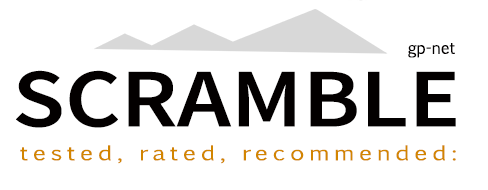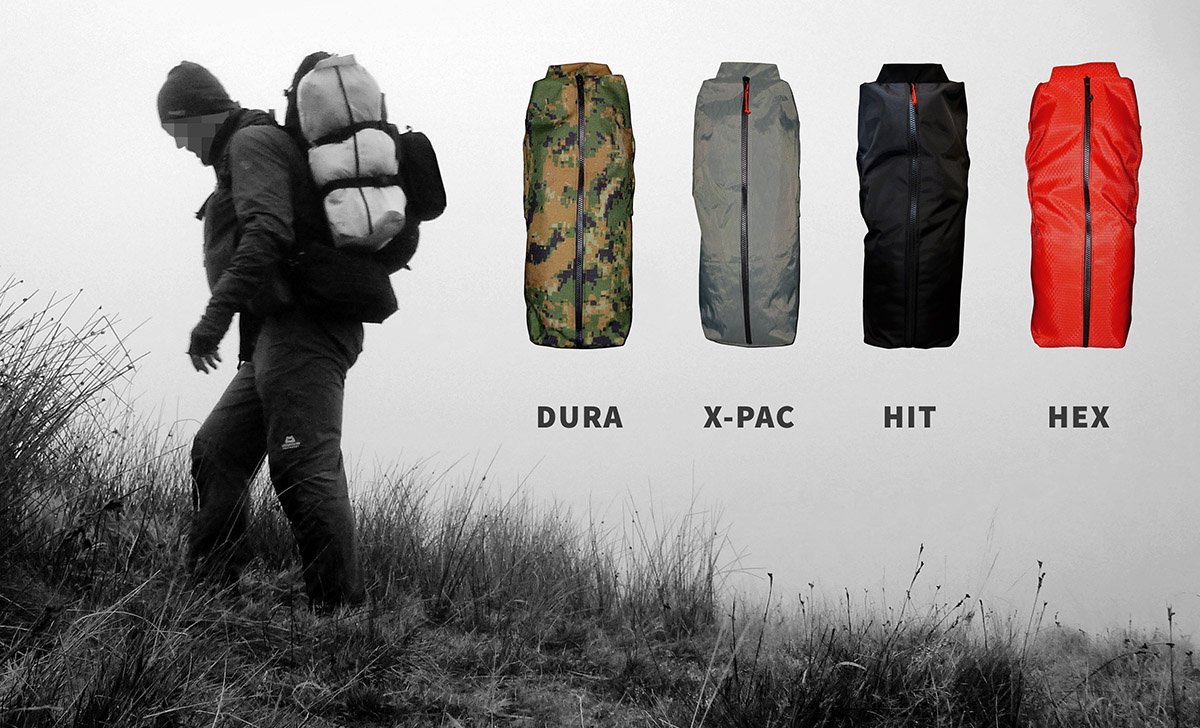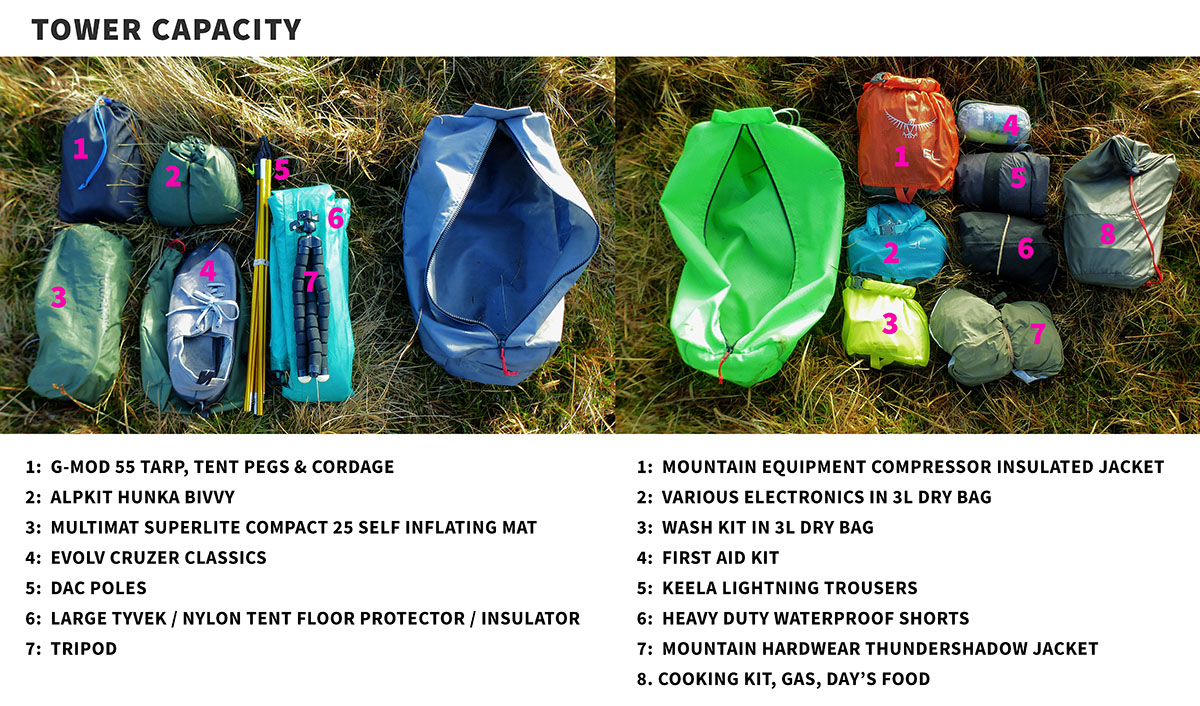Scramble's Tower 11L Full Zip Pack Extender
Preface
To understand why we made the Towers read our post "The Problem with Pouches, Pockets and Dry Bags". In addition we've outlined the reasoning behind our various design choices in a companion piece called "Accentuate The Positives, Eliminate The Negatives". This "review" focuses more on how the Tower performs in the field.
Note (25/11/24): The Tower has been updated and is now in version 2. For a quick guide to the new Tower range, please see the Tower V2 final release post.
As always, we're looking at the Scramble Tower from the point of view of long distance trekking over tough terrain.
Test subject: Chest 42", Waist 33", Height: 5ft 8"
Test item: 2018 HEX (Lime Green), 2018 HIT (Grey)
Kit Tests: Winter, Summer
Disclaimer: The Tower range is manufactured by Scramble. We made them because we weren't happy with existing offerings (as discussed here). So this is less of a review and more an outline of a product. Clearly we think they're the best, otherwise we wouldn't have gone to the trouble of developing and manufacturing them.
Datasheet
| Materials: (Nylon, varies depending on model, see materials below) | 100% |
| Treatments: Native or Applied DWR (depends on model) | - |
| Weight (depends on model, see table below) | 120g - 205g |
| Capacity (Cubic Litres) | 11 L |
| Dimensions (square based cuboid: H x W x D) | 50 x 15 x 15 cm |
| Country of Origin (Design & Manufacture) | UK |
| Scramble's Price on SYSTEM | £22.50 - £32.50 (depending on model) |
Scramble Review
Contents
- Introduction: What were we thinking?
- Why "Pack Extender"?
- Capacity
- Compatibility
- Centre of Gravity & Profile
- Weights & Materials
- Access & Security
- Abrasion & Water-Resistance
- Any Other Business?
- Conclusion, Rating & Product Pics
Introduction: What were we thinking?
Scramble currently recommend two very similar packs (though very different looking): the Karrimor SF Predator 30 our primary recommendation for general all-round mountain trekking (basically a climbing pack decorated in MOLLE) and the Blue Ice Warthog 40L (review coming) an outright climbing pack for those who often operate in sub zero temperatures, whose mountain treks regularly morph into something akin to mountaineering.
Both packs are minimalist, narrow, single cavity packs that sit high on the back (with a high centre of gravity) and importantly, both leave plenty of space for a harness or custom padded belt below.
Perhaps we're just romantic dreamers, but it's our view that a single 30L+ pack should suffice for all ones multi-day / multi-week trekking requirements, and for this reason we advocate packs that are extremely robust and importantly, can handle additional loads / capacity, i.e. they must be able to provide a degree of modularity.
For us, modularity doesn't just mean added capacity, it means the ability to be able to pack gear according to a simple "access principle":
There's kit you only need at point A and point B, and then there's stuff you may need between point A and B.
In plain English, there's a whole load of gear you don't touch between packing up your tent in the morning and setting it up at night: tent / bivvie, sleeping bag, sleeping mat, wash-kit, sleepwear, spare clothes, maps not yet required, remaining food rations etc ... In our view, this is what the body of a pack is designed to carry.
Personally, if I had to choose between the Predator 30 and Warthog 40, I'd go for Blue Ice's Warthog 40, simply because I spend enough time in sub zero conditions and the Warthog's ability to better accommodate an ice axe and helmet along with the additional 10L of space means room for both Defence 4 (outer) and Cloud Cover (inner) sleeping bags which will safely take me down to around -25°C. However, this was not the case until recently. The reason for this is the focus of this review.
The good thing about quality climbing packs is that they're extremely tough; the problem with them is that they're designed specifically for climbing and are not easily extensible.
At Scramble, for a long time we'd been looking for the ideal large capacity side pocket / pouch - we've tried everything the military and outdoor industry has to offer. Testing the Warthog 40 finally catalysed that frustration into action and we went about designing something that would suit packs like the Predator as well as climbing packs like those by Blue Ice, Crux et al.
If we were to succeed, the finished product would have to at least eliminate all the negatives of the available offerings we'd long griped about. As you can see below, we think we've succeeded.
We'll use this table to guide us through our outline of the Scramble Tower. So, let's finally take a look at these things:
A Giant Pencil Case? Kind of ...
In simple terms, the Tower is a giant pencil case, but it's a very tough one, made from a range of very high quality abrasion and weather resistant materials, it's surprisingly lightweight, it's designed to be attached to a pack and it's built to carry a wide range of gear ... but not pencils.
What's in a name?
The reason we called the Towers "Pack Extenders" rather than side pockets or side pouches is simply because these also work pretty well on the backs of certain packs. For example, in Summer we tested a single Tower prototype on the back of a Blue Ice Dragonfly 18L pack and it worked surprisingly well (turning the Dragonfly into a sub-500g ultralight 30L pack).
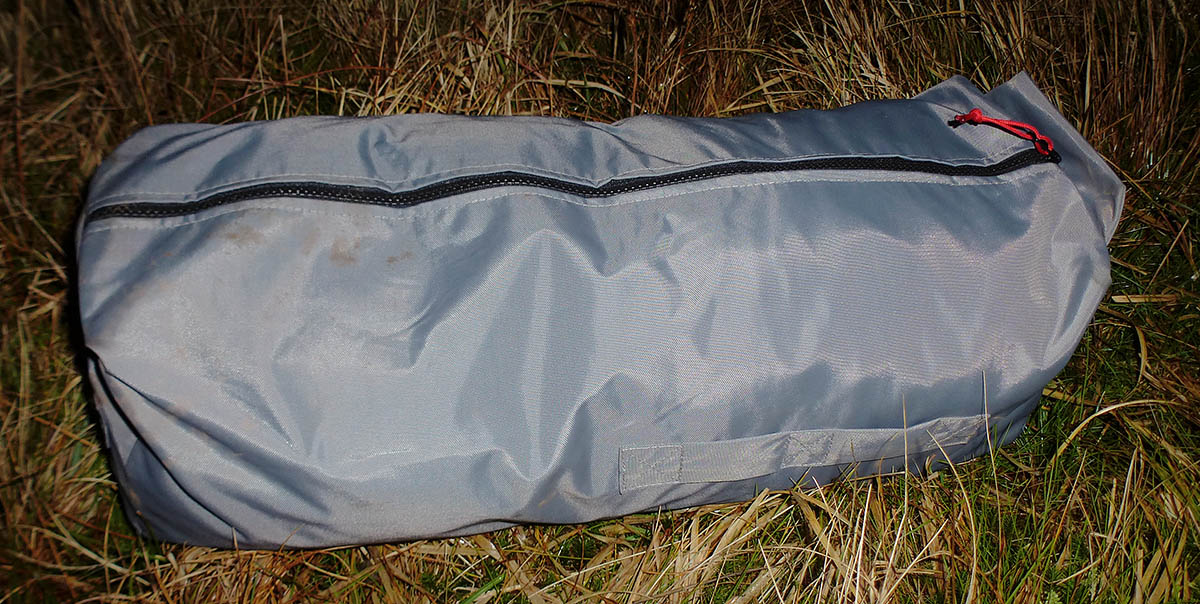 Pictured is the Grey HIT (420D High Tenacity Nylon version)
Pictured is the Grey HIT (420D High Tenacity Nylon version)
For our final (pre-production) test run of the Scramble Tower Pack Extender we took along two of the lightest in the range, the HEX (Lime Green) and the HIT (Grey). The thinking being "if these are tough enough, then the rest of the range most certainly are".
First of all let's see what these things can carry.
Capacity
The Tower is a square-based cuboid, standing 50cm tall with a 15 x 15cm base. If we do the maths, that gives us a capacity of 11.25 cubic litres, which we've generously rounded down to 11L.
For the final kit test I loaded the two Towers with as much stuff as possible (normally I don't take spare shoes with me on a trip). Here's what I was carrying:
Here's a less artificial but equally indicative view of what these things can handle. This is the actual kit I'll be carrying on the upcoming Winter 2019 Kit Test (as pictured above attached to the Blue Ice Warthog 40):
Compatibility
When we designed the Tower, we wanted it to work with any pack that would carry a regular closed-foam sleeping mat. We took our cue from the most universally compatible item we'd used: the dry bag, in particular Ortlieb's PD350 dry bags, which have an attachment loop at the base and another attachment point at the top. Then we decided to add only what's essential.
The compression straps, as they dig into the Tower (see pic #1 below), transfer the Tower's weight and downward force into the body of the pack, so just as dry bags or foam mats don't require loops to keep them in place, nor really does the Tower. Some packs like Blue Ice's Warthog 40 don't have quick release clips on the lower compression strap. So we included attachment loops only for the top compression strap; their role is twofold:
- To provide additional security should the pack's compression straps loosen
- To keep the compression straps approximately in place so that as you unclip the top compression strap to unzip the Tower (generally all kit is accessible with only one clip undone) the strap remains in place and is easy to re-clip (see the "access" pic below).
The Tower is designed to sit as high as possible, however some packs' compression straps are wider apart than others, thus the Tower has two rows of loops to make sure the lower compression strap will always have some Tower to bite into.
The Tower is designed to only use one of the four available side loops, as the quick release clip or buckle will often want to obscure one of the loops (see pic #3). Note: pictured below is a Tower stuffed to the gills (for test purposes), they can be packed half full and the compression straps ensure the load remains distributed vertically.
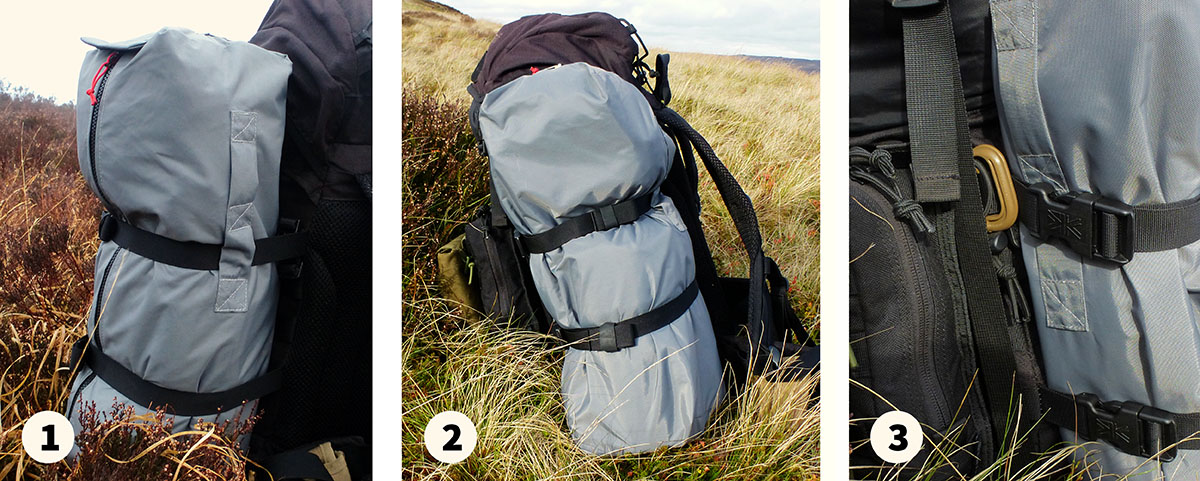 The Scramble Tower doesn't care which way it faces.
The Scramble Tower doesn't care which way it faces.
Having a square base maximises capacity and thus minimises the width profile, but just as importantly it makes the Tower agnostic as to which way it's facing. In picture #2 above you can see the Tower is in what we refer to as Storm/Transit mode.
There are times when you don't want to make access too easy; the Tower can be rotated in 90 degree intervals, so either the zip is fully hidden or it faces forward making access possible without removing the pack or backward if walking headlong into extreme weather (we'll get to weather-proofing later). Its default position is with the zip facing outward (see pic #1 above).
I found I either had the zip facing the pack when travelling and then when out in the field, I just had the zip facing outward in its default position, but I'm pretty sure that extreme weather will provide occasion to get funky and switch things around a little more.
Centre of Gravity & Profile
Although the Tower's nominal dimensions are 50(H) x 15(W) x 15(D) cm, in use (unless you're carrying a gold bar of the same dimensions) the compression straps will generally squash the Tower into the pack, making it more like 50(H) x 20(W) x 10(D) cm. As you can see below, this makes the Tower fit the depth profile of the Karrimor Predator 30, while only adding 10cm (20cm with two Towers) to its width. Narrow packs like the Predator 30 and Warthog 40, even combined with two Towers, will generally not exceed the width of its carrier's shoulders.
 The Scramble Towers aren't as bulky in use as you might expect.
The Scramble Towers aren't as bulky in use as you might expect.
As you can see above, the Towers, when combined with a good narrow climbing pack, offer a very high centre of gravity. This was one of the notable things from the final test, the pack balance was excellent and I felt pretty nimble during some relatively tricky scrambling.
(The 5 day Tower test run basically involved as much scrambling up mountains and running down them as possible in a vain attempt to break the Tower's side straps).
Weights & Materials
All the Towers are made from very tough, weather and abrasion resistant materials. The weights (as well as their prices) simply reflect the materials used; each has its own set of properties (we'll go into this in greater depth when we do our final product release post) and their chief attributes are roughly summarised in the table below.
The range is comprised of two groups, "core editions" and "limited editions", as their names suggest the core editions will hopefully always be available and make up the mainstay of the range; the limited editions are where we've sourced excellent materials with a specific function but cannot, at least to our satisfaction, guarantee a consistent supply.
- Core Editions: HIT, DURA, X-PAC
- Limited Editions (currently): HEX, NEO-LITE
 Colour coding weights: We've split the weights into Ultralight (130g or less = extreme), Midweight (between 130 and 170g = high) and Heavyweight (170g+ = good)
Colour coding weights: We've split the weights into Ultralight (130g or less = extreme), Midweight (between 130 and 170g = high) and Heavyweight (170g+ = good)
- HIT [Core Edition] (Blue, Grey, Olive Green) - the Black version will in time be phased out in favour of the similar black DURA500
Material: 225gsm PU Coated 420D High Tenacity Nylon
Attributes: light/mid-weight, very strong, highly abrasion and weather resistant
- DURA 500 [Core Edition] (Black)
Material: 270gsm 500D PU Coated Cordura
Attributes: mid-weight, very strong, highly abrasion and weather resistant
- DURA 850 [Core Edition] (Black)
Material: 390gsm 850D Acrylic Coated Ballistic Nylon
Attributes: heavy duty, extremely strong, extremely abrasion resistant and highly weather resistant
- DURA 1000 [Core Edition] (Blue, Grey, Olive Green, Camos - currently Digital G/B and Erebis ATP)
Material: 380gsm 1000D PU Coated Cordura
Attributes: heavy duty, extremely strong, extremely abrasion resistant and highly weather resistant
- X-PAC [Core Edition] (Slate Grey)
Material: 200gsm X-PAC VX21HS Laminate
Attributes: ultra-light, extreme strength, abrasion and weather resistance - hardcore across the board (all the virtues of the other models with no weight penalty)
- HEX [Limited Edition] (High Viz Lime Green, High Viz Red)
Material: 200gsm PU Coated 400D High Viz Nylon Hexagon Ripstop
Attributes: ultra-light, very strong, abrasion resistant and highly weather resistant
- NEO-LITE [Limited Edition] (Black)
Material: 205gsm Neoprene Coated Nylon
Attributes: ultra-light, strong, abrasion resistant and extremely weather resistant
Access & Security
First of all by security we're referring to how stable and secure the Towers are when strapped to a pack (not whether your stuff will get nicked). However, first we'll look at how easy it is to access gear, as this was one of the primary motivations for making the Towers, and why, for example all top-loading designs were dismissed. Here, the Bach XL Side Pockets came closest to nailing it but failed in a few non-trivial ways (which we noted here). Very simply, if you want a high centre of gravity, a reasonably narrow profile and easy access, you need a full length vertical zip.
With the Tower, we wanted to be able to easily access kit, preferably one handed, with winter gloves and get moving all in quick-time. I can confidently say that after all our testing, here the Tower excels. Nearly every time, I only needed to unclip the top compression strap and that provided access to pretty much all the kit I would need while on the go (of course you can pack with this in mind, for example I packed my cooking kit at the bottom as using this would mean at least a 30 minute break).
I tried re-attaching with one hand and although just possible, it's far quicker to use two.
In terms of how secure the Towers were, this wasn't that much of a surprise. I'd used Ortlieb PD350 dry bags on the last winter kit test, and these had held firm and though they did affect balance, they didn't shift or threaten to come loose.
The Towers were perfectly secure and interestingly, even though the test was pretty hardcore in terms of up and down jolting, sliding over scree and the like, quite often I noted the top compression strap hadn't even risen up to the top of the strap loop, meaning the loops weren't having to hold the Towers up at all (obviously this will vary depending on the pack's compression straps and particulalry the quality of the fasteners).
Abrasion & Water Resistance
All Towers will be able to handle the kind of abuse the majority of packs can handle. If you take Black Diamond's Speed Zip 33 alpine climbing pack for example (which uses a pretty standard combination of materials), its main body uses 210D ripstop nylon and the heavy stress areas are made from 420D abrasion resistant nylon (which is basically the same material as our 135g HIT model). Even the very lightest Tower (HEX), is made from high strength 400D hexagon ripstop. At the other end of the spectrum the ~200g DURA850 and DURA1000s are made from 850D Ballistic Nylon and 1000D Cordura respectively. As LoadedPocketz put it:
In the heavier fabrics, if you really want to split hairs, then 1050D Ballistic has a higher tear strength and 1000D Cordura has higher abrasion resistance. Both will hold up against anything that a typical user will throw at them. In most high end packs, seams and zippers will fail before the fabric will (which is why zipper quality is important too).
A nice segue into zippers.
The Towers use a moulded plastic YKK vislon zip. This completely non-snagging zip provides a good degree of water-resistance (but is not water-proof). For this reason the Tower has a waterproof peaked cap on its roof (which doubles as a grab tab when opening the zip) allowing water to drain away from the zip enclosure.
Additionally, all the stitching on the top section is seam sealed as is the stitching on all the attachment loops. All the materials used on the Towers have a waterproof inner coating, most are PU coated, the DURA850 has an acrylic coating and the NEO-LITE features a thick Neoprene coating (and is the most water-resistant).
Most of the range have a native (pre-applied) surface DWR treatment. The HEX has a heavily brush-coated DWR applied by us (we use Fabsil Gold on the roof and Fabsil Standard on the rest of the body).
The beauty of the Towers is that being so tough, you can use ultralight dry bags inside, so even if you take the heaviest bombproof model (the DURA1000) and include a large Sea To Summit Ultra-Sil Nano 8L dry bag (24g), the total weight is still a fraction less than an Ortlieb 13L (really 12L) dry bag. But with the Tower you get tougher protection, a narrower profile, a higher centre of gravity and much more convenient access to your gear (note: if you have items like down jackets, electronics etc. that you absolutely must keep dry, then a small ultralight (~ 20g) dry, zip-lock or plastic bag would be sensible, but things like cooking kit, water filters, waterproofs, tents, tarp poles etc. don't require that degree of protection, so dry bags can be used judiciously).
On the lighter side, if you choose the HEX or NEO-LITE models, the total weight (incl. the 8L dry bag mentioned above) is around 145g (substantially less than the Ortlieb PD350 13L or a Karrimor SF Sabre Side Pouch) and still lighter than even the much smaller capacity 6.5L Bach XL side pocket.
Any Other Business?
Just a few final points.
Firstly, we've been really lucky finding such a great company (based in the Scottish West Highlands) to partner with; they've decades of experience in the outdoor industry and their expertise and input has been invaluable. This is really the first time we've been able to control the entire design and manufacture process and consequently make the product as close to ideal as we're able. It's also very pleasing to design and manufacture a product entirely in the UK.
Finally a couple of unintentional yet positive aspects that arose from using the Towers:
- Stuffed full of all your clothes from the day's trek, the Tower makes an excellent pillow. Also, because it's zipped you can allow your damp clothes to breathe a little while you sleep.
- They make admin around your tent much easier; acting almost like a desk drawer, all the important stuff that always goes missing just when you most need it, can be safely deposited in the Tower.
- Because they're basically giant packing cells, they're really easy to pack in an organised and repeatable way (so you can quickly access your stuff).
- We designed the Tower expecting to only use one. For example with a hooped bivvie and ice axe providing a counter-weight on the other side. I've ended up using two (but there's no reason one may not suffice).
- It's useful, though not essential, having them in different colours. I found it helpful knowing for example, that all my waterproofs were in the green HEX. Obviously, you don't look so tidy, but if I cared about that I probably wouldn't sleep in a hole.
 Twin Towers in the mist under Scramble's G-Mod 55 UL tarp during the 5 day final test run.
Twin Towers in the mist under Scramble's G-Mod 55 UL tarp during the 5 day final test run.
Conclusion & Rating
We summed things up pretty well in our previous post "Accentuate The Positives, Eliminate The Negatives", we can't put it any better, so we'll just repeat ourselves:
Our favourite packs are the Karrimor SF Predator 30 and the Blue Ice Warthog 40 (review coming). The Scramble Tower is the perfect companion for both of these and pretty much all 30L+ packs on the market. The only packs that won't play well with the Tower are those with permanent protruding side pockets or over-designed clutter on the side - but basically if your pack can hold a closed cell foam sleeping mat, it very likely will host a Tower.
We looked at a number of 60L packs and noted their weights. If you add a couple of Towers to the Blue Ice Warthog for example, you end up with a very comfortable, agile, incredibly tough 60L pack that weighs just 1350g (much lighter than the vast majority of 60L packs out there). Since testing, the Scramble team have dumped their pouches, pockets and heavy duty dry bags. I have to admit I've done the same, it's basically solved all my load extension issues and has meant that as long as my 30/40L pack of choice can handle the load (without becoming uncomfortable) I can seriously extend its capacity and in so doing extend my range, especially in Winter when kit is always bulkier and heavier and at the same time reduce my overall pack weight.
Furthermore, it enables buyers of new packs to consider a different approach; being able to opt for a tough minimalist climbing pack knowing it can be configured and extended for touring / backpacking with the use of a Tower or two. The outdoor industry might not appreciate selling less packs, but at Scramble we've always had the view that one or two packs should really suffice (a small 20L pack and a 30/40L pack that can be extended to around 60L). The Tower makes that ideal a genuine reality.
Product Images
Rating (out of 10)
Scramble make the Tower 11L Full Zip Pack Extenders, and while we've tried to give a rating as objectively as possible (partly based on the idea of what the competition would have to improve upon for us to throw in the towel) please take this rating with a large amount of salt.
* The value score is derived from two factors:
1) Competitive Market Price (CMP). This represents our judgement of a competitive online price point if we were to stock the item. e.g. if we feel we would need to sell an item at 40% off (i.e. 60% of its full RRP) to be competitive, then our CMP score will be 6/10.
2) Customer Value Price (CVP). We then make an honest appraisal of the maximum price we would be willing to pay for the item (and we're mean). So if we'd pay 80% of its RRP our CVP score would be 8/10.
We then average the two scores to get our final value score, which in our example would be 7/10.
Last Updated: 09/02/19 (added picture of the Blue Ice Warthog 28 setup)
